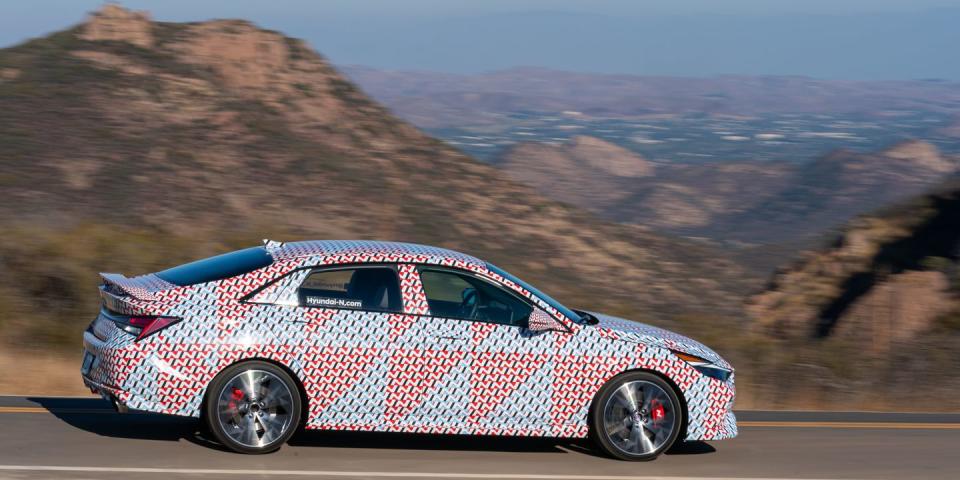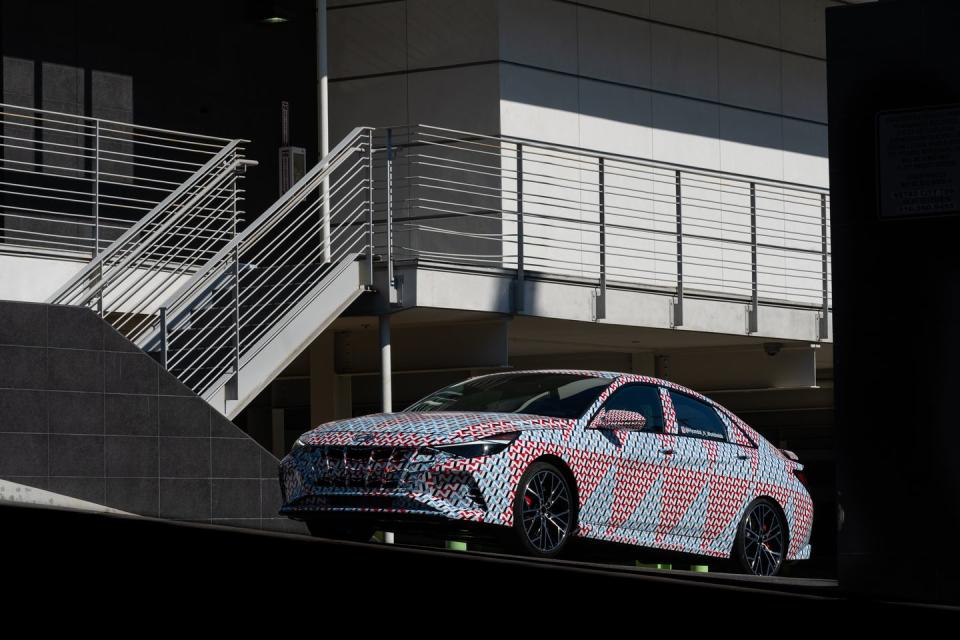Are Hyundai’s N and N Line as good as BMW M, Mercedes AMG, Audi S Line and Cadillac V?

Hyundai is expanding its performance N and N Line
Elantra and Sonata get N Line treatment
Elantra also gets more potent N upgrades
M, S, AMG, V, pretty soon we’re going to run out of letters of the alphabet. But not yet.
The latest performance trim line of sporty coupes and sedans in the automotive world now comes from Hyundai, yes, Hyundai. There has been a Hyundai N Line version of the Veloster for two years now. And at the end of this month you can get an Elantra N Line, followed by a more-potent Elantra N and Sonata N Line and N. More on those in a minute.
It’s all in the letters. For decades we’ve had performance upgrades on cars labelled BMW M, Mercedes AMG, Audi S, RS and S Line, and Cadillac V.
And we saw that they were good.

Chances are you were around when the original BMW E30 M3 came out, and maybe you, too, freaked out just a little bit when you first drove one: such perfect balance, such perfect pedal and steering efforts, such immediate responses to every input… (My first drive of an E30 M3 came at no less a perfect venue than the Nurburgring, and I was amazed. It remains one of, if not the, most perfect drive(s) I’ve ever experienced. Likewise, I loved the E36 M3, too. Maybe you did as well. Of course you did).
The Audis were as good in their own distinct way. The in-house tuning entity Audi Sport GmbH makes high-performance versions of the company’s regular road-going coupes, sedans and wagons. Right now you can go down to your Audi dealer and get nine Audis in RS versions, from the RS3 sedan to the RS Q8, including the R8 Coupe and Spyder.
Take the Audi A3, for instance. The base A3 gives you 184 hp, 0-60 in 6.6 seconds, and a 130-mph top speed for $34,295. Not bad. But step up to the S3 and you get 288 hp, 0-60 in 4.6 seconds, top speed of 155 mph for $43,995. Then above those two is the RS3 giving you 394 pulverizing ponies, 0-60 in 3.9, same top speed due to tires of 155 mph and an entirely reasonable $56,200.
Likewise, AMG has lined up a huge variety of Mercedes products for your consideration. You could have a reasonable and efficient C 300 sedan, for instance: 0-60 in 5.7 seconds, 255 hp four-cylinder and a $41,600 sticker price. You could step up to an AMG C 43 and get to 60 in 4.5 with a 385-hp 3.0-liter twin-turbo V6 for $55,950. Or you could realize that you only live once and get the mighty AMG C 63 with its 469-hp twin-turbo 4.0-liter V8 for $68,100 and really have a good time.
And last but not least, consider the Cadillac CT4. In base trim its 2.0-liter turbo four sends 237 hp to the rear wheels for $33,990. But step up to the CT4-V and its 2.7-liter “dual-volute” (it has to do with how the exhaust is routed to the turbo) makes 325-hp, plus you get a limited-slip differential, magnetic ride control and full Brembos for $45,490.
So Hyundai looked at the spec sheets of all those cars, saw the commensurate prestige that came with them and said, “We can do that!” Two years ago we saw the Veloster N with 275 turbocharged hp, a sportier chassis and sportier looks. That was above the 201-hp Veloster Turbo. The Veloster N also gets N Light Sport bucket seats, electronically controlled suspension, “N Corner Carving” differential and a six-speed manual for $32,250.
That was also good.
Now Hyundai wants to join the performance alphabet game by expanding its N and N Line products to include the Elantra and Sonata, and maybe others in the future. The plan now is to have seven vehicles by 2022.
“We definitely wanted to establish a performance aspect to the brand,” said Mike Evanoff, senior manager of product planning for Hyundai Motor America. “We've talked about electrification, and hybrids and everything, we have the mainstream core vehicles, the sedans, the SUVs, I think we're maybe missing a little bit on the performance side.”
“Hyundai has increased its quality so much in the last 20 years, it's amazing,” said Hyundai’s Derek Joyce. “We're consistently near the top of JD Power surveys and we've really enhanced our style over the last 15 years, you know, really making big bounds in our styling, and appeal in those ways. A lot of our multimedia and infotainment applications are quite cutting edge, very sophisticated and on the cutting edge of what consumers want. But the last element we have wanted to add is sportiness and visceral appeal, an emotional appeal of our cars. And we couldn't really do that without doing an N Line or an N brand because we need dedicated vehicles that true hardcore enthusiasts aspire to enjoy. So it enhances the overall brand it also provides a genuine outlet for those buyers. They don't have to go elsewhere. They don't need to go to other brands they can stick with Hyundai, and have those enthusiasts needs satisfied by a Hyundai model.”
The N Line includes performance upgrades as well as cosmetic trim touches, while the N is all about pure performance.
“N line is obviously a big step up from the from the base car or the normal car,” said Evanoff. “It's not just badges and an aero kit, there are actually engine differences, suspension differences, the engineers work on it underneath that you can't see. So it is a performance increase, not just cosmetics.”
From that, the N goes up several notches.
“But then the N takes it even further,” Evanoff continued. “Thermal management you can use up a half to a full tank of gas on the track without any issues. It has larger brakes, larger wheels, summer tires are standard. It makes it a little bit more horsepower, more everything. There’s the electronic limited-slip differential, which is hydromechanical, electronically controlled suspension. It's just that next level of performance.”
“The N is really the purist, enthusiast’s model,” said Joyce. “And the differentiator for N is that an N vehicle has the capability for sustained track performance, with heat dissipation capability to allow you to go to a track day, and enjoy the vehicle all day and then still drive at home.”
People are going to take Elantras, Sonatas and Velosters to the track?
“Yes, they'll take them to the racetrack, absolutely,” said Evanoff. “I see it all the time. I follow all the boards. People are tracking them and doing very well with them. There are no issues that I've heard of. Albert Biermann and everyone on his team, they encourage that. They we've had (Veloster N) ownership events in Germany, where they take their i30s to the track, to the Nurburgring, they’ve had sponsored events. So it's definitely encouraged.”
So while the Veloster N continues, the news here is the arrival of the Elantra N Line and Sonata N Line models by the end of this year and the Elantra N next year. You can read about the Sonata N here.
The Elantra N Line gets stiffened up all around, from the springs and shocks to the stability bars and the stability bar mounts. Even the engine mounts are stiffened up 14 percent. The front brakes are larger and the tires are Hankook Ventus S1 all seasons or Goodyear WEagle F1 summer tires. The engine goes from a 2.0-liter naturally aspirated 147 hp four in the base model to 201-hp 1.6-liter GDI turbo in the N Line. It drives like the competent if occasionally underpowered sedan it is. Mostly you’ll be happy in it. Until you drive an N.
The Elantra N is the sport compact model, kind of a four-door sedan version of a Veloster N. Exact specs are not out yet, but it has a more powerful version of the Veloster’s 2.0-liter engine making 276 hp and 289 lb ft of torque. My press vehicle came with a six-speed manual but it’s also available with an eight-speed DCT.
Maybe the Hyundai people like me, but for whatever reason, while all my colleagues had one-mile short hops in the car, I got to take a 50-mile long haul through the Santa Monica Mountains, including many of my favorite twisty roads. The Elantra N is promising, at least among small, sport compact front-wheel drive cars. Compared to a Honda Civic Si, since it’s a sedan and the Civic Type R is a hatchback, it has a lot more horsepower and a lot more driving modes for greater control of your mood and the terrain. The GTI is likewise down on power to the Veloster N but might feel a bit more refined behind the wheel. Okay, the GTI feels a lot more refined. The Elantra N has a snickety shifter and a springy clutch pedal, as if designed to counter vague car magazine complaints that no one could translate to Korean. What would be good is smoother clutch takeup and engagement, a less artificial feel to the shifter and a lighter feel to the steering. Likewise, the suspension was too stiff, as if we were all driving on billiard-table-smooth race tracks. But I have the same complaint about a lot of supercars, the roads in the real world are bumpy, man!
Can Hyundai’s N and N Line compete with the likes of M, S, RS and AMG? Those cars are several classes up, so no. But it can be compared to the VW GTI, and there the GTI’s decades of refinement are clear. That is not to say Hyundai should give up. Keep working on these Ns and N Lines. The world needs sporty cars and Hyundai has shown its ability to create quality, and then luxury with its Genesis division. Performance can’t be too far behind.

 Yahoo Autos
Yahoo Autos 